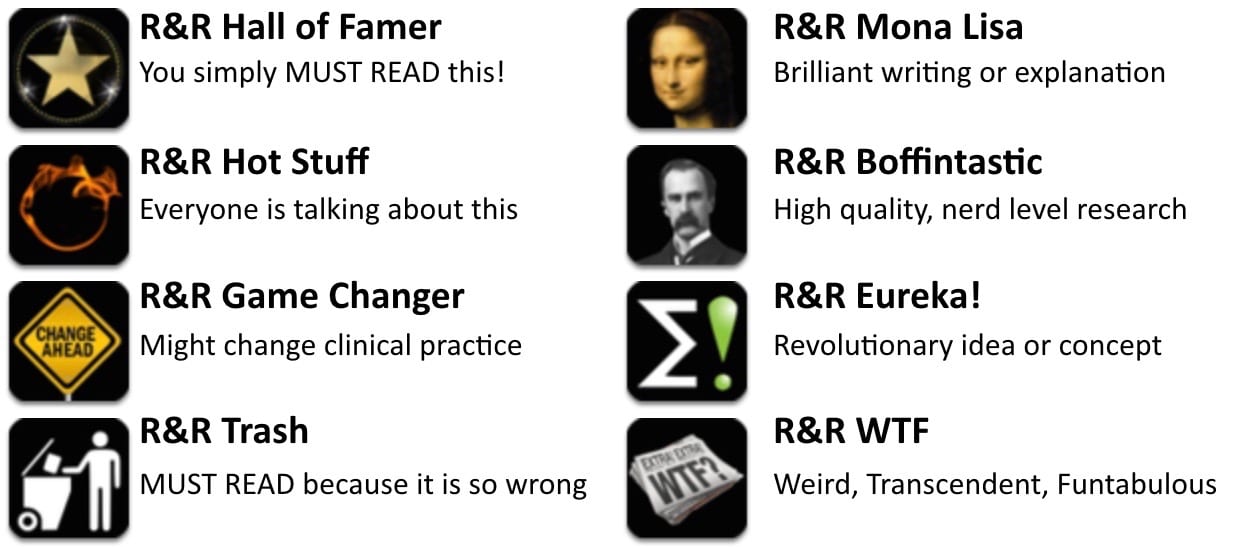R&R In The FASTLANE 083
Welcome to the 83rd edition of Research and Reviews in the Fastlane. R&R in the Fastlane is a free resource that harnesses the power of social media to allow some of the best and brightest emergency medicine and critical care clinicians from all over the world tell us what they think is worth reading from the published literature.
This edition contains 6 recommended reads. The R&R Editorial Team includes Jeremy Fried, Nudrat Rashid, Soren Rudolph, Anand Swaminathan and, of course, Chris Nickson. Find more R&R in the Fastlane reviews in the : Overview; Archives and Contributors
This Edition’s R&R Hall of Famer
Moler FW et al THAPCA Trial Investigators. Therapeutic Hypothermia after Out-of-Hospital Cardiac Arrest in Children. NEJM 2015. PMID: 25913022
- More evidence to support not cooling patients. This trial involving 295 comatose children who survived after an Out of Hospital Cardiac Arrest showed that therapeutic hypothermia as compared to therapeutic normothermia did not confer a survival benefit with a good functional outcome at 1 year. Rates of infections and arrhythmias were similar between groups. Questions remain about the role of targeted temperature management in children.
- Recommended by: Nudrat Rashid
Debaty G et al. Impact of intra-arrest therapeutic hypothermia in outcomes of prehospital cardiac arrest: a randomized controlled trial. Inten Care Med 2014. PMID: 25348858
- How early after ROSC should cooling start? Upon reaching the hospital or prehospital? How about before ROSC? This study looks at intra-arrest cooling in the prehospital setting. No benefit was found for either the surrogate markers or the most important patient centered outcome of survival. Interestingly, the median temperature upon hospital presentationin the group that did not get intra-arrest cooling was 35 degrees (below the 36 degrees recommended in the TTM trial conclusions). Intra-arrest cooling may simply be a lot of money and effort spent without noticeable differences in outcomes.
- Recommended by: Anand Swaminathan
- Read More: JC: Getting Chilly Quickly 3. Hypothermia at St.Emlyn’s (St Emlyn’s)
Walkey AJ. Long-term Outcomes Following Development of New-Onset Atrial Fibrillation During Sepsis. Chest 2014; 146(5):1187-95. PMID: 24723004
- This is an interesting observational study using secondary data analysis, in this case claims data. The aim was to study incidence and outcomes of new onset Afib during sepsis. It happens to be common (7%) with recurrence being very common (55%). Patient with new-onset Afib during sepsis have a higher risk of death, heart failure and stroke compared with patients without it.
- Recommended by: Daniel Cabrera
Vali Y et al. Investigating and managing suspected pulmonary embolism in an outpatient setting: the Leicester experience. Thorax 2015; 70(3): 291-3. PMID: 24764115
- A hospital in Leicester, UK set up an ambulatory management program for patients with low risk PE (HR <110 bpm, SBP >100 mm Hg, O2 sat >92% on RA, RR <30 bpm, no syncope, normal troponin, and no large central clot or right heart strain on CTPA) and looked at their results over two years.They discharged 70/96 (73%!!) of PE patients. They report that no discharged patients died from causes related to PE or the treatment of PE.Of course this is just one hospital with a relatively small sample size. But the study does suggest that with appropriate selection criteria and the right outpatient resources, ambulatory management of PE is a feasible and practical route.
- Recommended by: Zack Repanshek
Duch P1, Møller MH. Epidural analgesia in patients with traumatic rib fractures: a systematic review of randomised controlled trials. Acta Anaesthesiol Scand 2015. PMID: 25683770
- Pain following traumatic rib fractures is often managed by continuous epidural analgesia (CEA). In this systematic review of randomised controlled trials the benefit and harm of CEA is compared with other analgesic interventions in patients with traumatic rib fractures.
In 223 trials all with high risk of bias the authors found quality and quantity of evidence in support of CEA to be low, and there is no firm evidence for benefit or harm of CEA compared with other analgesic interventions. - Recommended by: Søren Rudolph
Brown DJ. Accidental hypothermia. NEJM 2012; 367(20): 1930-8. PMID: 23150960
- This article provides a wonderful summary of the current recommendations of how to best care for the cold patient, and also provides some amazing information on some extreme cases. For example, the longest reported duration of CPR with full neurological recovery after extracorporeal rewarming is 190 minutes! Additionally, the importance of ECMO or bypass is stressed as an important aspect of care for the severely hypothermic patient as survival rates with full neurological recovery can be altered from less than 37% to as high as 63%. Other useful numbers are also provided, such as consideration of cessation of CPR for patient with Potassium levels greater than 12 mmol/L.
- Recommended by: Jeremy Fried
Intensivist and Donation Medical Specialist, Australia | @NudratRashid |







